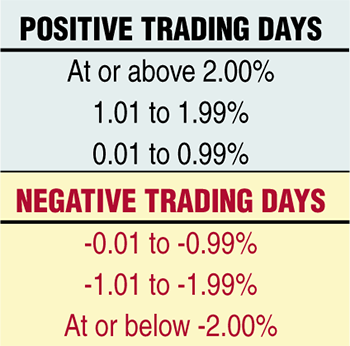TRADING TECHNIQUEs
Hindsight For Foresight
Looking Forward With Yesterday’s Action
Can you determine how prices will move after looking at yesterday’s price action? This analysis measures price movement on the S&P 500 Spdr exchange traded fund for the next three days.
No matter how you finish the trading day, knowing how the market will perform over the next few trading days can provide you with a competitive advantage. How can you do it? You can run an analysis that measures the results of the next three days after the Standard & Poor’s 500 depositary receipt (Spdr) exchange traded fund (Spy) experiences a price movement.
For instance, after the Spy produces a trading day advance of 2.5%, how does it perform one, two, or three days after this upside rally? Are these results comparable over the next three days? Does a 1.5% run to the upside respond differently, or is it more profitable to purchase the Spy after it experiences less of an upside move? Are these results likely to hold for a large, moderate, or small downside loss?
Success comes from playing the percentages; by making an assessment of the existing trading environment; performing your analysis; and formulating your trading decisions without emotional distractions. Nevertheless, it is difficult to put the percentages on your side without knowing how the equities market performs after a range of moves. Getting this information and using it effectively can separate an unexceptional performance from an excellent one.
The spiders
The Spy (also known as the “spiders”), with an average daily trading volume of 242 million shares, outpace the market in the Etfs category. As the most active instrument, the spiders offer the best representation of investor psychology. With extremely active pre- and aftermarket trading volume, the spiders are an attractive trading choice, since it normally has just a penny difference between the bid and the ask prices. This liquidity is an important feature because few instruments offer the investor a reasonable bidding price to buy or asking price to sell outside of the regular trading session.

Figure 1: positive vs. negative days. Here are the daily price movements of the spiders broken into six categories, with two brackets, separating positive from negative trading days.